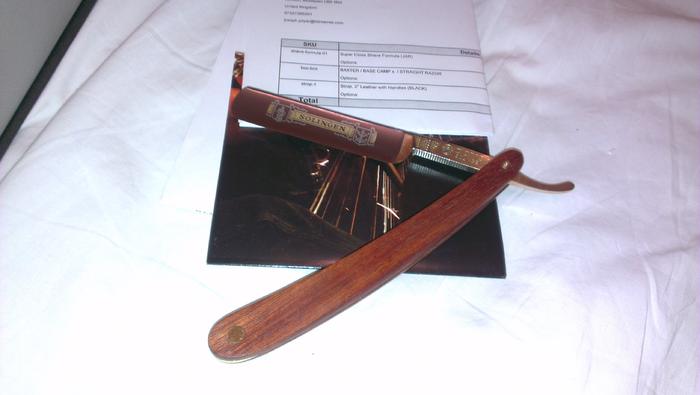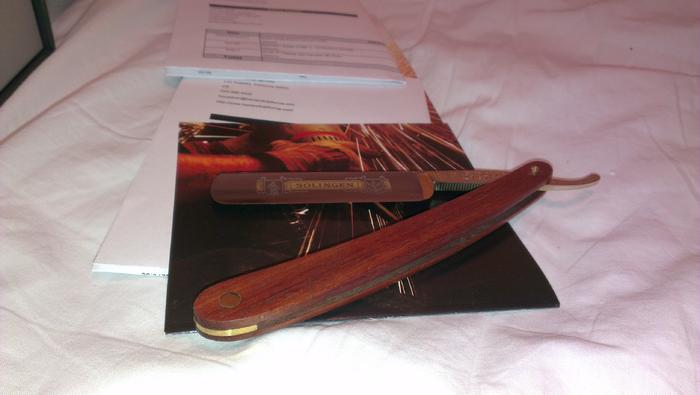Results 11 to 20 of 22
Thread: Pastes and such
-
06-26-2013, 05:08 PM #11

Now it's right

This type of razor is not difficult to hone and it does not usually take much time to get a good edge.
Although the picture is large, it is not possible to see the honewear which however does not seem to be bad.
Let's suppose the one who honed your razor did a good job, we know you used a lot of paste in order to have it sharp. At this point my conclusion is that your razor is overhoned, something happening when you strop too much a blade on a paste.The RazorGuy - StraightRazorChannel on Youtube and Google+
-
06-26-2013, 06:12 PM #12
-
06-26-2013, 06:13 PM #13

Should i buy these and forget about the diamond pastes????
The Classic Brand Lapping Pastes, 2oz
-
06-26-2013, 07:04 PM #14

Scales look wonderful for sure.
Why are you paying so much attention on pastes? You seem to like pastes quite a lot but, like I wrote, if you make an excessive use of them the blade will become overhoned and the blade will not cut like it should.
So, my advice is:
1) take a break from pastes: the more you use them the worse for your razor's edge
2) don't be obsessed to have a lot of them: a good quality chromium oxide paste is all you need
3) pay scrupulous attention on your stropping technique: this makes a big difference both for razor's life and quality of shaving
4) don't use pastes on a regular basis. Use a chromium oxide paste only when the razor starts pulling
5) in case the razors pulls after having passed it on chromium oxide, consider honing it with a fine grit hone (natural or synthetic) and then a good strop on chromium oxide (say, from 5 to 10 passes)
6) strop and stropping are more important than pastes
You should also consider many straight razor users do not advise the use of pastes as they are considered a "sort of advanced technique". Stropping is (almost) everything.The RazorGuy - StraightRazorChannel on Youtube and Google+
-
06-26-2013, 07:23 PM #15
-
06-26-2013, 07:29 PM #16
-
06-26-2013, 07:40 PM #17
-
06-26-2013, 08:01 PM #18

I thought it was warranted!
-
06-26-2013, 08:43 PM #19

For daily maintenance, I use about 30 strokes linen and 50 leather on an unpasted hanging strop immediately after shaving and again immediately before my next shave. Stropping is harder to do than it seems, has a significant effect on edge quality, but can dull a shave ready edge when it is not done well. Unfortunately, there is no getting around learning to strop well since it must be done for each shave.
I usually use my hanging strop with it laying flat on the flat edge of my bathroom sink counter for greater control. It is important that the counter surface used for stropping on a laid down hanging strop be really flat, and not slightly up turned at its edge for drip control, or the strop will not lay flat for the razor.
Try for a stroke feel of full edge contact and smoothness rather than speed. Do not be afraid to wipe your blade and your strop, if you perceive any gritty feel or possible dirt contamination of the strop during a stroke.
A finishing hone, a barber's hone, or a pasted strop are the traditional means of refreshing an edge. Pasted strops for refreshing an edge appear to be more popular in the EU than in the US. When stropping with the unpasted strop fails to revive my razor edge, I use a pasted strop for 5 to 20 strokes followed by wiping the blade clean and re-stropping with the unpasted strop. This usually recovers my edge. If the unpasted strop still fails, I repeat the pasted strop one or two more times.
When the pasted strop clearly has lost its effectiveness, it is time for a blade touch-up on the finishing hone, or a full re-honing progression (typically about 1k, 4k, 8k, optional higher-K finisher). Learning to hone is also an acquired skill. It is feasible to send blades out for re-honing as honing is needed less frequently than stropping.
If you are going to try your own honing, consider trying the 8k or finisher before going to the 4k, and the 4k before dropping down to the 1k as one does not want any more hone wear on a blade than the minimum necessary. If a blade requires the 1K hone, the bevel must be set correctly on the 1K hone before the 4K hone will be effective, unless you hone a very long time. Using a high grit stone on a blade prematurely is like trying to shape a board using ultra-fine sandpaper. A finely finished wooden object is possible only after the saw, the plane, and course sandpaper have 1st done their work.
I make my own pasted bench strops from Hand American honing leather. 3 x 12 inch planed hard wood boards and 3-M 77 spray adhesive. I get these supplies locally from Woodcraft, but there are other sources. Popular choices for "pastes" include 3, 1, 0.5, or 0.25 um diamond sprays, CrOx, and red/black Dovo pastes.
Dovo Paste Dovo Strop Paste, Red and Black 2-Part Set | RoyalShave
Hand American Diamond Spray, leather, and CrOx Hand American
Diamonds work well on hard and stainless steel blades, but some feel that the edges produced are somewhat harsh. Bench strops are cheap to make and easy to use. Why not try them out and see what you think of the results. One can always try a finishing hone or a full honing progression if the strops do not work out as well as desired.
Pasted strops need not be wasted, they also work well on kitchen knives in lieu of steeling the blades. I keep a separate set of pasted strops for my knives.
DMT diamond plates work well on hard and stainless steel knives and are superb for flattening/refreshing stones before honing razors.
HTHLast edited by sheajohnw; 06-26-2013 at 08:48 PM.
-
06-28-2013, 04:43 AM #20

Thanks for that info.. The only thing that im not 100% sure about is,when im stropping: should there be any pressure applied to the blade? I strop with no pressure but surely there should be a tiny amount?


 3Likes
3Likes LinkBack URL
LinkBack URL About LinkBacks
About LinkBacks








 Reply With Quote
Reply With Quote

